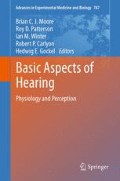Abstract
Listeners with sensorineural hearing loss (SNHL) often show poorer thresholds for fundamental-frequency (F0) discrimination and poorer discrimination between harmonic and frequency-shifted (inharmonic) complex tones, than normal-hearing (NH) listeners—especially when these tones contain resolved or partially resolved components. It has been suggested that these perceptual deficits reflect reduced access to temporal-fine-structure (TFS) information and could be due to degraded phase locking in the auditory nerve (AN) with SNHL. In the present study, TFS and temporal-envelope (ENV) cues in single AN-fiber responses to band-pass-filtered harmonic and inharmonic complex tones were measured in chinchillas with either normal-hearing or noise-induced SNHL. The stimuli were comparable to those used in recent psychophysical studies of F0 and harmonic/inharmonic discrimination. As in those studies, the rank of the center component was manipulated to produce different resolvability conditions, different phase relationships (cosine and random phase) were tested, and background noise was present. Neural TFS and ENV cues were quantified using cross-correlation coefficients computed using shuffled cross correlograms between neural responses to REF (harmonic) and TEST (F0- or frequency-shifted) stimuli. In animals with SNHL, AN-fiber tuning curves showed elevated thresholds, broadened tuning, best-frequency shifts, and downward shifts in the dominant TFS response component; however, no significant degradation in the ability of AN fibers to encode TFS or ENV cues was found. Consistent with optimal-observer analyses, the results indicate that TFS and ENV cues depended only on the relevant frequency shift in Hz and thus were not degraded because phase locking remained intact. These results suggest that perceptual “TFS-processing” deficits do not simply reflect degraded phase locking at the level of the AN. To the extent that performance in F0- and harmonic/inharmonic discrimination tasks depend on TFS cues, it is likely through a more complicated (suboptimal) decoding mechanism, which may involve “spatiotemporal” (place-time) neural representations.
Access this chapter
Tax calculation will be finalised at checkout
Purchases are for personal use only
References
Harding GW, Bohne BA (2007) Distribution of focal lesions in the chinchilla organ of Corti following exposure to a 4-kHz or a 0.5-kHz octave band of noise. Hear Res 225:50–59
Heinz MG, Swaminathan J (2009) Quantifying envelope and fine-structure coding in auditory-nerve responses to chimaeric speech. J Assoc Res Otolaryngol 10:407–423
Heinz MG, Colburn HS, Carney LH (2001) Evaluating auditory performance limits: I. One-parameter discrimination using a computational model for the auditory nerve. Neural Comput 13:2273–2316
Hopkins K, Moore BC (2007) Moderate cochlear hearing loss leads to a reduced ability to use temporal fine structure information. J Acoust Soc Am 122:1055–1068
Houtsma AJM, Smurzynski J (1990) Pitch identification and discrimination for complex tones with many harmonics. J Acoust Soc Am 87:304–310
Kale S, Heinz MG (2010) Envelope coding in auditory nerve fibers following noise-induced hearing loss. J Assoc Res Otolaryngol 11:657–673
Kale S, Micheyl C, Heinz MG. Implications of within-fiber temporal coding for perceptual studies of F0-discrimination and discrimination of harmonic and inharmonic tone complexes. (submitted)
Liberman MC (1984) Single-neuron labeling and chronic cochlear pathology. I. Threshold shift and characteristic-frequency shift. Hear Res 16:33–41
Louage DH, Van Der Heijden M, Joris PX (2004) Temporal properties of responses to broadband noise in the auditory nerve. J Neurophysiol 91:2051–2065
Moore BC, Glasberg BR, Hopkins K (2006) Frequency discrimination of complex tones by hearing-impaired subjects: evidence for loss of ability to use temporal fine structure. Hear Res 222:16–27
Moore BC, Hopkins K, Cuthbertson S (2009) Discrimination of complex tones with unresolved components using temporal fine structure information. J Acoust Soc Am 125:3214–3222
Siebert WM (1970) Frequency discrimination in auditory system – place or periodicity mechanisms? Proc IEEE 58:723–750
Zilany MSA, Bruce IC (2006) Modeling auditory-nerve responses for high sound pressure levels in the normal and impaired auditory periphery. J Acoust Soc Am 120:1446–1466
Acknowledgments
This work was supported by NIH R01-DC009838 (SK and MGH) and R01-DC05216 (CM). Some of the results presented in this chapter are described in greater detail elsewhere (Kale et al. submitted).
Author information
Authors and Affiliations
Corresponding author
Editor information
Editors and Affiliations
Rights and permissions
Copyright information
© 2013 Springer Science+Business Media New York
About this paper
Cite this paper
Kale, S., Micheyl, C., Heinz, M.G. (2013). Effects of Sensorineural Hearing Loss on Temporal Coding of Harmonic and Inharmonic Tone Complexes in the Auditory Nerve. In: Moore, B., Patterson, R., Winter, I., Carlyon, R., Gockel, H. (eds) Basic Aspects of Hearing. Advances in Experimental Medicine and Biology, vol 787. Springer, New York, NY. https://doi.org/10.1007/978-1-4614-1590-9_13
Download citation
DOI: https://doi.org/10.1007/978-1-4614-1590-9_13
Published:
Publisher Name: Springer, New York, NY
Print ISBN: 978-1-4614-1589-3
Online ISBN: 978-1-4614-1590-9
eBook Packages: Biomedical and Life SciencesBiomedical and Life Sciences (R0)

